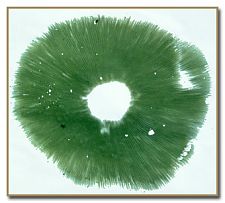Chlorophyllum molybdites
 (Also known as Lepiota molybdites)
(Also known as Lepiota molybdites)
Vomiter or Green-spored Parasol
Order Agaricales, family Agaricaceae
CAP LARGE, WHITE WITH BROWN SCALES
Cap: 5-30 cm wide; oval, then broadly convex to flat; dry; white with buff patches on center when young, then white with light brown scales; flesh white, not staining when bruised or bruising dingy reddish brown; in button stage often bruises reddish brown within 60 seconds
 GILLS FREE, WHITE BECOMING GRAYISH-GREEN IN AGE
GILLS FREE, WHITE BECOMING GRAYISH-GREEN IN AGE
Gills: free, close, broad; white becoming grayish to greenish
STALK WITH THICK MOVABLE RING
Stalk: 5-25 cm long, 1-2.5 cm thick at apex, enlarging at base; smooth; white, discoloring brownish
Ring: double-edged, often movable
 SPORE PRINT GRAYISH-GREEN
SPORE PRINT GRAYISH-GREEN
Spores 9.5-12 x 6.5-9, elliptical, thick-walled with apical pore, smooth, dextrinoid
GROWS IN GRASS ON LAWNS
POISONOUS
Lookalikes:
Shaggy parasol (Chlorophyllum rhacodes) -- white spores, less bulbous stalk, thicker scales, stain more orangey
Agaricus sp. – white, then pinkish gills that turn chocolate brown
Coprinus comatus – elongated cap, flesh does not change color, gills inky at maturity
YOU MIGHT ALSO LIKE TO KNOW...
In his little-known book, the Marriage of the Sun and the Moon, Dr. Andrew Weil wrote that vomiting can induce a natural high. Unfortunately, most people who have eaten the vomiter (C. molybdites), turned green, and vomited all night would have deep doubts about this. At best, they would probably say that the floor of the bathroom or a hospital bed is the wrong "set and setting" for a "high" of any kind.
C. molybdites is probably the most common cause of mushroom poisoning (but never yet causing death) in the U.S. People often eat this mushroom in the evening, thinking it is a shaggy mane (Coprinus comatus) or a button mushroom (Agaricus). Then in the middle of the night, a doctor informs Marilyn Shaw, a nationally-known mushroom-poisoning expert, that a patient in the emergency room has vomited 20 or 30 times during a three-hour period. She has heard about the tell-tale vomiting so many times that she is almost certain that C. molybdites is the culprit, even before the doctor describes the mushroom to her. In fact, Marilyn has had so many midnight calls from doctors describing the poisonings from C. molybdites and other mushrooms that she now recommends that people eat mushrooms for breakfast. That way, she figures, she won't get middle-of-the-night wake-up calls from bewildered emergency-room doctors, who know only that a mushroom killed the father of Babar, the elephant in the mycophobic children's book.
City mushroom hunters have no choice but to learn this fungus. It's one of the most common, growing mostly on grass. It can appear all summer long, but fruits most often toward the end of the season, when it's mistaken for a shaggy parasol (Chlorophyllum rachodes) or a shaggy mane. But the vomiter mushroom has a greenish spore print. Don't make a mistake unless you want to vomit a lot.
Incidentally, while urban-grazing kids are more likely to get sick from small poisonous mushrooms that grow in the grass, adults go for C. molybdites, probably because it's a big mushroom that looks good. And it tastes good, at least according to those who have later regretted knowing how it tastes. (Pueblo, Colorado, mushroomer Karen Adams said black Labrador dogs also apparently think C. molybdites tastes good, and do not die from eating it.)

